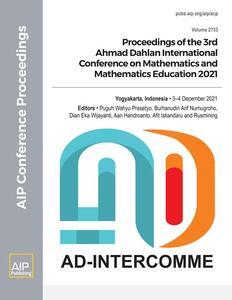Suwandi, Suwandi and Utaminingsih, Sri and Darmanto, Eko (2023) THE EFFECTIVENESS FACTORIZATION MEDIA BASED ON ANDROID ON THE ACHIEVEMENT OF STUDENTS’ LEARNING OUTCOMES. AIP CONFERENCE PROCEEDINGS, 2733 (1).
![[thumbnail of COVER AIP CONFERENCE PROCEEDINGS]](https://eprints.umk.ac.id/20980/1.hassmallThumbnailVersion/COVER%20ARTIKEL%20SUWANDI.jpeg)  Preview |
Text (COVER AIP CONFERENCE PROCEEDINGS)
COVER ARTIKEL SUWANDI.jpeg - Published Version Download (40kB) | Preview |
Preview |
Text (RESERACH ARTICLE THE EFFECTIVENESS FACTORIZATION MEDIA BASED ON ANDROID ON THE ACHIEVEMENT OF STUDENTS’ LEARNING OUTCOMES)
8 SUWANDI, SRI UT, EKO_2.pdf Download (668kB) | Preview |
Abstrak
The purpose of this research is to describe the effectiveness of developing android-based prime factorization learning media in improving mathematics learning outcomes. The research design used in this research is to use the experimental research method Quasi-Experimental Design in the form of Nonequivalent Control Group Design consisting of control and experimental classes. Data collection techniques using observation, documentation, and tests. While the data analysis technique used is a descriptive quantitative analysis of the results of the pretest and posttest scores using SPSS 23 software. The normality test uses Shapiro Wilk because the sample is less than 50 students. The homogeneity test aims to determine whether the object under study has the same variance using the Levene homogeneity test. The analysis used to test the research hypothesis is the independent sample t-test and Normalized Gain (N-Gain). The results of the study in the form of pretest and posttest values using android-based prime factorization learning media showed that at t-count of 19,544 or 19,544 > 4,004. It means that there is a significant difference in learning outcomes of prime number factorization material before implementing learning and after implementing learning using learning media android-based prime factorization. The value of n gain% is 56.3108 on a fairly effective interpretation, which means Learning using android-based prime factorization learning media is quite effective in improving student learning outcomes for fourth-grade elementary school students in the factorization of prime numbers.
| Item Type: | Article |
|---|---|
| Subjects: | Pendidikan > Pendidikan (Umum) Pendidikan > Teori dan praktek pendidikan |
| Program Studi: | Fakultas Keguruan & Ilmu Pendidikan > Magister Pendidikan Dasar (S2) |
| Depositing User: | Mrs Sri Utaminingsih |
| Date Deposited: | 05 May 2024 19:17 |
| Last Modified: | 05 May 2024 19:17 |
| URI: | http://eprints.umk.ac.id/id/eprint/20980 |
Actions (login required)
 |
View Item |